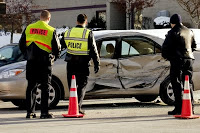Category Archive: Safe Driving

Will 16 Year Olds Lose Their Driving Privileges?
September 1, 2006
According to new scientific studies, the area of the brain that controls impulsive behavior doesn’t reach maturity until the age of 25. This has caused many people to reconsider the age that teens should be allowed to drive. Currently, many states allow teens as young as 16 the right to drive. However, statistics have proved that 16 year olds are dangerous drivers, have the highest auto related death rates, and more teens die while riding in vehicles driven by 16 year olds. What is interesting is that even though many parents and politicians feel that 16 is too young to drive, there is a certain degree of hesitancy when it comes to changing existing laws.
Some people look to the fact that many parents are tired of chaperoning their teens and look forward to the day when they can manage some of the responsibility of transportation themselves. But, ask any parent who has lost a child in a teen related auto accident, and they will quickly tell you that they would gladly chauffer their teen if it meant having their child back in their lives again.
Nearly all states have implemented changes that affect the way teens drive. Some of these changes include limiting the amount of passengers teens may have in the vehicle or decreasing the amount of time teens can drive alone. Nevertheless, though these rules have been put in place to help keep teens safe, they are frequently not enforced.
There is often a misconception behind the reasons why teens are involved in so many fatal accidents. The fatal accidents are often mistakenly blamed on alcohol or drugs. However, as current studies have shown, it is a matter of brain maturity, and not excessive teen drinking that contributes to the high rate of deaths associated with teen drivers.
When people put pressure on politicians to raise the drinking age, changes were made that ensured the drinking age would be 21. This has been a positive change that has undoubtedly saved many lives. Unfortunately, it seems that it may take more fatal accidents before politicians realize that the best way to protect teens from the dangers of driving is to similarly raise the driving age.
Read more driver education news in the Safe Driving Teen Monthly Bulletin. Each month the National Safety Commission publishes the bulletin for teens and parents designed to improve teen driver behavior, attitude, skills, and experience. Subscription Details

Is 16 Too Young to Drive?
August 28, 2006
On an average day in the USA, 10 teenagers are killed in teen-driven vehicles. This has caused many officials to question what age teens should be allowed to drive. OK- are you ready from some scary statistics? USA Today studied deadly crashes that took place during the year 2003. Of those accidents that involved drivers between the ages of 16-19, more people died throughout that year then for any disease or teen related injury. Are you ready for the numbers, how about 3,500 teenagers? That’s right, 3,500 teenagers died during the year 2003 from driver related accidents in teen driven vehicles. The statistics are frightening, and have caused many people to ask if teens really are ready to drive. Well, now it seems that science may be answering that question.
New scientific research has shown that the part of the brain that helps control impulsive behavior and helps rationalize the cause and effect of such behavior doesn’t fully develop until roughly the age of 25. You know how everyone says that teens believe they are immortal? Well, according to these studies, it’s true. But the reality is that we aren’t. And it is sad to say, but 3,500 teens in 2003 proved that they weren’t. So what are we to do?
Another point that the statistics show is that 16 year olds are involved in more fatal accidents and are worse drivers than all other teen drivers. In fact, states like New Jersey that restrict 16 year olds from driving have the lowest teen death rates in the entire country. There are a number of different reasons that make 16 year olds unsafe drivers and increase their chances of being involved in a fatal car crash. Some of these include:
- Sixteen year olds are inexperienced drivers. Many parts of the country, such as the South have unsafe streets, even for the most experienced drivers. Teens don’t have the skills to drive on these rural roads.
- Teens often drive vehicles that are prone to roll. SUVs, pickup trucks, and small cars top the list.
- Teens often drive after dark and with other teens in the car. This can cause serious distractions and make it difficult to use all of the senses needed to be a safe driver.
- Alcohol and speeding plays a vital role in many fatalities.
No matter how old you are you should take these things into consideration and drive safely and carefully. If you don’t feel comfortable, then don’t drive. Never drink and drive, don’t drive after dark, and stay away from unsafe roads. Also, limit the number of passengers that you allow in the car with you. Your life is more important than your popularity. Sure, if you are killed in a teen driven car crash your name will be in the paper, your friends, family members, even strangers will come to your funeral and remember you, and your school may hold a day of remembrance in your honor, but is that really the kind of popularity that you want? Play it safe and smart and use good judgment when driving.

Unbelted Teen Killed in Crash
August 3, 2006
Missouri teen Charles “Charlie” J. Glik, 16, was driving at about 3 a.m. when his car left the roadway and struck a utility pole, police said. The impact snapped the pole in half, and Charlie, who was not wearing his seat belt, died at the scene..
Source: stltoday.com
Safe Driving Lesson Learned
In 28 of the states with belt use laws in 2004, the law specified secondary enforcement. That is, police officers are permitted to write a citation only after a vehicle is stopped for some other traffic infraction.
As of December 2004, 49 states and the District of Columbia had belt use laws in effect. The laws differ from state to state, according to the type and age of the vehicle, occupant seating position, etc.
Research has found that lap/shoulder safety belts, when used, reduce the risk of fatal injury to frontseat passenger car occupants by 45 percent and the risk of moderate-to-critical injury by 50 percent. For light truck occupants, safety belts reduce the risk of fatal injury by 60 percent and moderate-tocritical injury by 65 percent.
Among passenger vehicle occupants over 4 years old, safety belts saved an estimated 15,434 lives in 2004.
Wear your safety belt and shoulder harness properly. In a crash, you are far more likely to be killed if you are not wearing a safety belt. Wearing shoulder belts and lap belts make your chances of living through a crash twice as good.
Airbags, combined with lap/shoulder safety belts, offer the most effective safety protection available today for passenger vehicle occupants. Research indicates an overall fatality-reducing effectiveness for airbags of 11 percent when a safety belt is used in conjunction with the airbag. In 2004, an estimated 2,647 lives were saved by airbags.
This post is an excerpt from a recent edition of the Safe Driving Teen Monthly Bulletin. Each month the National Safety Commission publishes the bulletin for teens and parents designed to improve teen driver behavior, attitude, skills, and experience. Subscription Details

Car Surfing claims the life of Nashville Teen
August 1, 2006
Police say Shawn Nipper, 16, was car surfing on McGavock Pike in Two Rivers Park on a Saturday night when he died.
Car surfing is where you stand on the roof of a moving car and try to keep your balance while the vehicle is moving. Police say it’s one of the most dangerous stunts you can pull with a car.
The victim’s family says this so-called car surfing is a dangerous, growing trend that parents need to be aware of before it claims more young lives.
Source: newschannel5.com
This post is an excerpt from a recent edition of the Safe Driving Teen Monthly Bulletin. Each month the National Safety Commission publishes the bulletin for teens and parents designed to improve teen driver behavior, attitude, skills, and experience. Subscription Details

Teenagers Involved in One Third of Fatal Automobile Crashes
July 24, 2006
About one third of the people killed in automobile crashes involving the nation’s youngest drivers were pedestrians or occupants of other vehicles, according to a recent report. An analysis of federal crash statistics by the AAA Foundation for Traffic Safety found that nearly 31,000 people were killed in crashes involving drivers between the ages of 15 and 17 between 1995 and 2004. The foundation said it was surprised to learn that one-third of those deaths involved pedestrians and people in other vehicles.
Source: SeattleTimes.nwsource.com
Safe Driving Lesson Learned
According to the National Highway Traffic Safety Administration, on the basis of miles driven, teenagers are involved in three times as many fatal crashes as are all drivers. Why do young drivers have such poor driving performance?
Three factors work together to make the teen years so deadly for young drivers:
- Inexperience
- Risk-taking behavior and immaturity
- Greater risk exposure
With graduated driver licensing, new drivers typically go through a three-stage process that involves their gradual introduction to full driving privileges. By restricting when teenagers may drive, and with whom, graduated driver licensing allows new drivers to gain much-needed on-the-road experience in controlled, lower-risk settings. It also means that a teenager will be a little older and more mature when he or she gains a full, unrestricted license. After the young driver demonstrates responsible driving behavior, restrictions are systematically lifted until the driver “graduates” to full driving privileges.
This post is an excerpt from a recent edition of the Safe Driving Teen Monthly Bulletin. Each month the National Safety Commission publishes the bulletin for teens and parents designed to improve teen driver behavior, attitude, skills, and experience. Subscription Details
